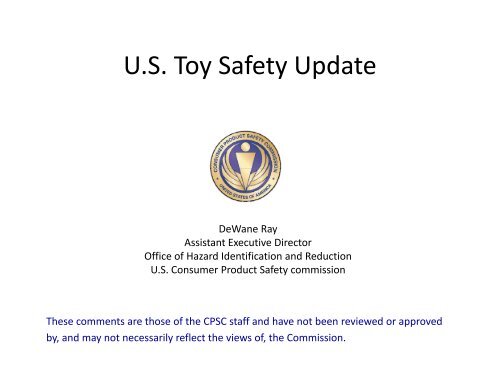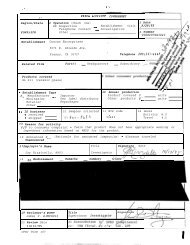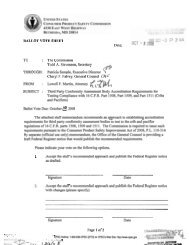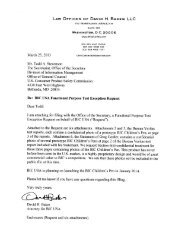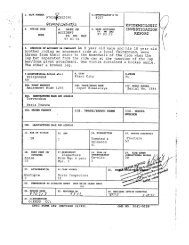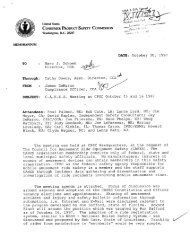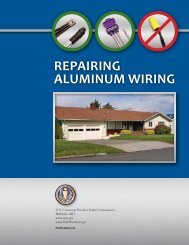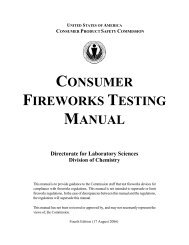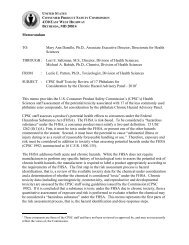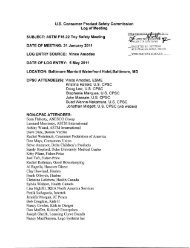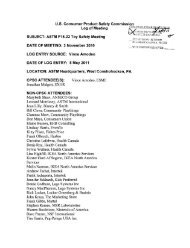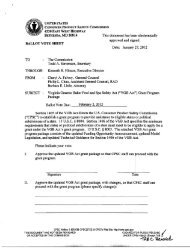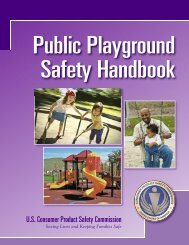U.S. Toy Safety Update - Consumer Product Safety Commission
U.S. Toy Safety Update - Consumer Product Safety Commission
U.S. Toy Safety Update - Consumer Product Safety Commission
Create successful ePaper yourself
Turn your PDF publications into a flip-book with our unique Google optimized e-Paper software.
U.S. <strong>Toy</strong> <strong>Safety</strong> <strong>Update</strong><br />
DeWane Ray<br />
Assistant Executive Director<br />
Office of Hazard Identification and Reduction<br />
U.S. <strong>Consumer</strong> <strong>Product</strong> d <strong>Safety</strong> f commission<br />
These comments are those of the CPSC staff and have not been reviewed or approved<br />
by, and may not necessarily reflect the views of, the <strong>Commission</strong>.
Presentation Outline<br />
•Recent injury data associated with toys.<br />
•U.S. toy regulations and requirements for children’s products.<br />
•<strong>Toy</strong> standard revisions revisions.<br />
•Recent amendments to CPSIA.<br />
•Discussion of third party testing requirements and CPSC laboratory<br />
accreditation program.<br />
•Discussion of recent <strong>Commission</strong> action on continued testing and<br />
certification of children’s products and component part testing.
Reported <strong>Toy</strong>-Related Deaths Among Children Less Than 15 Years of Age 2008–2010<br />
Type of <strong>Toy</strong> (Hazard) 2008 2009 2010<br />
TOTAL 25 15 17<br />
Balloons (airway obstruction, aspiration, asphyxiation) 2 2 5<br />
Tricycles (drowning, motor vehicle involvement) 4 4<br />
RRubber bb bballs/other ll / th small ll ball b ll (airway ( i obstruction, b t ti aspiration, i ti choking, h ki<br />
asphyxiation)<br />
2 3<br />
Nonmotorized riding toys/unspecified riding toys (fall, motor vehicle<br />
involvement, drowning)<br />
4 1<br />
<strong>Toy</strong> boxes (asphyxiation, entrapment, drowning) 1 1 2<br />
Nonmotorized scooters (motor vehicle involvement) 2 1 1<br />
St Stuffed ff d t toys/doll /d ll accessory (suffocation, ( ff ti aspiration) i ti ) 1 2 1<br />
Balls, other (motor vehicle involvement, drowning) 2 1<br />
Powered riding toys (drowning) 2<br />
Other toys with a single reported fatality in the year (asphyxiation,<br />
drowning, gastroesophageal hemorrhage, toy pierced eye/brain)<br />
7 2 4<br />
Source http://www.cpsc.gov/library/toymemo10.pdf<br />
In 2010, 65% of the reported deaths involved balloons, small balls, game, and accessory parts.
Annual <strong>Toy</strong>-Related Emergency Department-Treated Injury Estimates 2006–2010<br />
Calendar Year<br />
Total<br />
All Ages<br />
Estimated Injuries<br />
Less Than 15 Years of Age Less Than 5 Years of Age<br />
Per 100,000<br />
People<br />
Total<br />
Per 100,000<br />
People<br />
Total<br />
Per 100,000<br />
People<br />
2006 220,500 74 165,100 271 78,400 380<br />
2007 232,900 77 170,100 278 80,200 383<br />
2008 235,300 77 172,700 280 82,300 389<br />
2009 250,100 81 185,900 300 90,600 425<br />
2010 * 2010 251 700 82 181 500 293 89 200 419<br />
* 251,700 82 181,500 293 89,200 419<br />
Source http://www.cpsc.gov/library/toymemo10.pdf<br />
•Riding d <strong>Toy</strong>s are associated d with h more emergency ddepartment treated d<br />
injuries than any other category, of which nonmotorized scooters<br />
accounted for 70% of the estimated injuries.<br />
•The majority (97%) of emergency department treated toy‐related injury<br />
victims were treated and released.
<strong>Toy</strong>-Related Emergency Department-Treated Injury Estimates for All Ages,<br />
Children Less Than 15 Years of Age, and Children Less Than 5 Years of Age<br />
1996–2010
Overview of U.S. <strong>Toy</strong> Regulations<br />
• Age grading of toys<br />
• Requirements for <strong>Toy</strong>s under the<br />
Federal Hazardous Substances Act (FHSA)<br />
• New requirements q under the<br />
<strong>Consumer</strong> <strong>Product</strong> <strong>Safety</strong> Improvement Act (CPSIA)<br />
• Mandatory <strong>Toy</strong> Standards<br />
ASTM F963‐2008 with toy chest provision<br />
( (previously i l voluntary)<br />
l t )
• Age grading:<br />
Age Grading of <strong>Toy</strong>s<br />
– matches the attributes of the toy to the capabilities of the child; and<br />
– is used to determine the appropriate tests to which a product must<br />
comply.<br />
• When determining whether the age grade on the product is appropriate<br />
the <strong>Commission</strong> considers:<br />
– the manufacturer’s labeling g on the p product, , if it is reasonable; ;<br />
– whether the product is advertised, promoted, and marketed for that age<br />
child;<br />
– whether the product p is recognized g commonly y by y consumers as being g<br />
intended for that age child; and<br />
– Age Determination Guidelines – September 2002.
Key Mandatory <strong>Toy</strong> Standards<br />
• Small Parts Requirements 16 C.F.R. Part 1501<br />
• Labeling Requirements 16 C.F.R. § 1500.19 and<br />
16 C.F.R. § 1500.121<br />
• Art Material Requirements 16 C.F.R. § 1500.14(b)(8)<br />
• Lead‐in‐Paint 16 C.F.R. Part 1303<br />
• Electrically Operated <strong>Toy</strong>s/ 16 C.F.R. Part 1505<br />
Children’s <strong>Product</strong>s<br />
• Sharp Point/ Edge Requirements<br />
16 CFR C.F.R. § § 1500 1500.48/49 48/49<br />
• Children’s <strong>Toy</strong>s (ASTM F963)
<strong>Consumer</strong> <strong>Product</strong> <strong>Safety</strong><br />
Improvement Act (CPSIA) of 2008<br />
9
<strong>Consumer</strong> <strong>Product</strong> <strong>Safety</strong><br />
Improvement Act (CPSIA) of 2008<br />
• “Children’s products” designed or intended<br />
primarily i il for f children hild 12 years old ld and d<br />
younger<br />
• KKey substantive bt ti requirements i t for f children’s hild ’<br />
products :<br />
– Lead content ontent in aaccessible essible components omponents (100 ppm)<br />
– Lead in paint and surface coatings (90 ppm)<br />
– Phthalates (0.1% (0 1% per banned phthalate) – <strong>Toy</strong>s<br />
and Child Care Articles<br />
– <strong>Toy</strong> <strong>Safety</strong> Standard (ASTM F963‐08) F963 08)<br />
10
• Key process requirements for children’s products<br />
primarily intended for children 12 years old and<br />
younger:<br />
– Third party p ytesting g by y CPSC‐accepted p labs;<br />
– Conformity certificates issued by importers &<br />
manufacturers; and<br />
– TTracking ki lbl labels.<br />
• New safety rules for durable infant products:<br />
– Cribs Cribs, infant walkers walkers, bath seats seats, toddler beds beds, play<br />
yards, bed rails, additional items every 6 months; and<br />
– <strong>Product</strong> registration g cards.<br />
• www.Safer<strong>Product</strong>s.gov – Publicly Searchable<br />
Database<br />
11
Stay of enforcement lifted on December 31, 2011 !!<br />
• Children’s Children s <strong>Toy</strong>s (ASTM F963)<br />
• Banned Phthalates<br />
• Total l Lead d C Content (Manuf. ( f after f 8/14/11) 8/ / )<br />
All regulated children’s children s products manufactured<br />
after December 31, 2011 must be/have:<br />
11. Third Party Tested (CPSC Accepted Lab)<br />
(* Small Batch Manufacturers may not require 3PT)<br />
22. Children’s Children s <strong>Product</strong> Certificate<br />
12
CPSIA Requirements<br />
• Section 101 Children’s <strong>Product</strong>s Containing Lead;<br />
Lead Paint Rule<br />
• Section 102 Mandatory Third Party Testing for<br />
Certain e a Children’s de s<strong>Product</strong>s oduc s<br />
• Section 103 Tracking Labels for Children's <strong>Product</strong>s<br />
• Section 105 Labeling Requirement for Advertising<br />
<strong>Toy</strong>s and Games<br />
• Section 106 Mandatory <strong>Toy</strong> <strong>Safety</strong> Standards<br />
(currently ( y ASTM F963–2008, , including g toy y chests from 2007) )<br />
• Section 108 Phthalate Requirements
CPSIA Section 102: Certification<br />
• Most ost consumer co su e products p oducts that t ataesubject are subject to<br />
mandatory standards or bans must be certified as<br />
in compliance with each applicable requirement.<br />
– Domestic products: manufacturer must certify.<br />
– IImported t dproducts: d t iimporter t must t certify. tif<br />
• Children’s Children s products must be certified based on<br />
testing performed by a CPSC‐accepted third party<br />
testing g<br />
lab.
Third Party Testing and Certification for<br />
Children’s hild ’ <strong>Toy</strong>s Subject bj to Small ll Parts<br />
• <strong>Toy</strong>s intended for children under three (3) years of age must meet<br />
requirements for small parts (as received and after testing).<br />
• <strong>Toy</strong> is subject to use and abuse testing based on the intended<br />
“age age grade” grade of the product and must not produce small parts parts. Testing<br />
is performed by a CPSC‐accepted third party<br />
testing lab.<br />
• BBased don that h test, the h iimporter or manufacturer f must issue i a certificate ifi of f<br />
conformity that certifies the product complies with<br />
small parts requirements.<br />
– The certificate must accompany each shipment when it enters<br />
U.S. commerce and must be furnished to the retailer or distributor.
CPSIA Section 103: Tracking Labels<br />
• Required q for all children’s products p manufactured<br />
after August 14, 2009.<br />
• Permanent markings are required on the<br />
package and on the product where practicable practicable,<br />
including:<br />
– Location and date of production; p ;<br />
– Cohort information;<br />
– Batch, run number, or other identifying<br />
characteristics; and<br />
– Identifying mark determined by the manufacturer to<br />
facilitate ascertaining the source of the product.
CPSIA Section 106: Mandatory <strong>Toy</strong><br />
Standards d d<br />
• Most provisions of ASTM F963‐07 F963 07 became<br />
mandatory for toys made after February 10,<br />
2009.<br />
• <strong>Commission</strong> accepted most provisions, and<br />
<strong>Commission</strong> accepted most provisions, and<br />
ASTM F963‐08 became mandatory for toys<br />
made after August 17, 2009<br />
(did not accept the deletion of toy box<br />
provision).
Partial List of Requirements in ASTM<br />
F963‐08 F963 08<br />
• Sound‐Producing g <strong>Toy</strong>s y<br />
• Wheels, , Tires, , and Axles<br />
• Battery‐Operated <strong>Toy</strong>s<br />
• Small Objects<br />
• Stuffed and Beanbag‐type g yp <strong>Toy</strong>s y<br />
• Projections<br />
• Marbles and Balls<br />
• Folding g Mechanisms and Hinges g<br />
• Hemispheric‐Shaped Objects<br />
• Cords and Elastics in <strong>Toy</strong>s<br />
• Yo‐Yo Yo Yo Elastic Tether <strong>Toy</strong>s<br />
• Magnets<br />
• Pacifiers<br />
• Balloons<br />
• Projectile <strong>Toy</strong>s<br />
• Certain <strong>Toy</strong>s with Spherical Ends<br />
• Rattles<br />
• Teethers and Teething <strong>Toy</strong>s<br />
• Squeeze <strong>Toy</strong>s
ASTM F963‐08 F963 08<br />
• Not All Sections of ASTM F963 Apply to Every<br />
<strong>Toy</strong>.<br />
• Some Sections of ASTM F963 Require Third<br />
Party Testing, Some Sections Do NOT Require<br />
Third Party Testing. Testing<br />
• Some Sections of ASTM F963 Are Covered by<br />
Ei Existing i CPSC Regulations R l i in i the h CFR (Code (C d of f<br />
Federal Regulations 16 CFR Part 1000 to End).<br />
19
ASTM F963 Sections<br />
TTesting i NNot RRequired i d<br />
• Sections that address requirements for labeling, instructional<br />
literature, or producer’s markings;<br />
• Sections that involve assessments that are conducted by the<br />
unaided eye and without any sort of tool or device.<br />
• Sections that pertain to the manufacturing process, and thus,<br />
cannot be evaluated meaningfully by a test of the finished<br />
product (e.g., the purified water provision at section 4.3.6.1);<br />
and<br />
• Sections that address food and cosmetics.<br />
20
ASTM F963 Sections<br />
NNotice i of f Requirements<br />
R i<br />
• Page 3 of the Notice of Requirements (“NOR”) ( NOR) sets forth the<br />
specific sections in ASTM F963‐08 (and ASTM F963‐07) that<br />
require q third pparty ytesting. g<br />
• Notable Sections:<br />
– T<strong>Toy</strong> Ch Chests t ASTM F963 F963‐07 07<br />
– Surface Coating Material – Soluble Test for Metals<br />
21
ASTM F963 F963‐11 11 What's What s new?<br />
• Heavy Metals‐Limits Metals Limits for toy substrates<br />
• Compositing Procedure for Total Heavy Metal<br />
Analysis<br />
• Bath <strong>Toy</strong> Projections<br />
• Other revisions to include: jaw entrapment;<br />
toys with spherical ends; stability of ride on<br />
toys; requirements for squeeze toys attached<br />
to rings; use of cords, straps and elastics;<br />
packaging film; and yo‐yo tether balls.
When will I be required to comply with<br />
the h new standard? d d<br />
• CPSC has 90 days from notification (March<br />
2012) to reject in whole or in part, the revised<br />
standard if it does not improve safety safety.<br />
• The revised standard (if accepted by CPSC) will<br />
become effective 180 days from notification<br />
(June 2012).
What about third party testing?<br />
• Third party testing will continue to be required<br />
for methods that did not change.<br />
• For new or revised test methods methods, third party<br />
testing will not be required until the CPSC has<br />
issued a notice of requirements for these<br />
changes.
CPSIA Amendments Enacted<br />
Into Law in August 2011<br />
25
CPSIA Amendments<br />
• HR 2715 enacted into law in August 2011,<br />
with almost unanimous approval by U.S.<br />
Congress.<br />
• Provide targeted regulatory relief to<br />
businesses.<br />
• Maintain all significant enhancements to<br />
public safety from the CPSIA.<br />
26
CPSIA Amendments<br />
• Lead Content Limit<br />
• Phthalates<br />
• Third Party Testing<br />
• Small Batch Manufacturers<br />
• Other Amendments
LEAD CONTENT LIMIT
Lead Content Limit<br />
CPSIA Amendments<br />
• 100 ppm maximum applies only to products manufactured on or after<br />
August 14, 2011<br />
• Off‐road vehicles (i.e., ATVs, ROVs, snowmobiles) now exempt<br />
• Used children’s products now exempt, if:<br />
– product was donated for charitable purposes; or<br />
– product was obtained from someone who originally obtained the<br />
product for use (and not for resale).<br />
– exemption does not apply to:<br />
• children’s metal jewelry;<br />
• any children’s product for which the donating party or seller<br />
has actual knowledge g that the pproduct<br />
violates the lead<br />
content limit; or<br />
• any other children’s product identified by the CPSC (after a<br />
hearing).<br />
• 300 ppm maximum for bicycle components made of metal<br />
29
CPSIA Amendments<br />
Lead Content Limit<br />
• CPSC may grant exceptions for products if:<br />
– Lead is required because it is not practicable or not technologically<br />
feasible to manufacture the product by removing the excessive lead<br />
or by making the lead inaccessible;<br />
– The product (or any of its components) is not likely to be placed in<br />
the mouth or ingested, taking into account normal and reasonably<br />
foreseeable use and abuse; and<br />
– The exception will have no measurable adverse effect on public<br />
hhealth lthor safety, ft tki taking iinto t account t normal l and d reasonably bl<br />
foreseeable use and abuse.<br />
• Any party seeking ki an exception i must satisfy if the h CPSC S that h it i<br />
meets these requirements.<br />
30
PHTHALATES
CPSIA Amendments<br />
Phthalates<br />
• Phthalate content limits – like the lead content limits –no<br />
longer apply to inaccessible parts of children children’s s toys and<br />
child care articles.<br />
• A part is inaccessible if it is not physically exposed by<br />
reason of f a sealed ldcovering<br />
or casing.<br />
• The inaccessible parts excluded from the phthalate<br />
content limits may y not become pphysically y yexposed p through g<br />
“reasonably foreseeable use and abuse of the product,”<br />
including:<br />
– Swallowing Swallowing, mouthing mouthing, breaking breaking, aging aging, or children’s children s activities<br />
with the product.<br />
32
THIRD PARTY TESTING
CPSIA Amendments<br />
Third Party Testing<br />
Excluded from Third Party Testing Requirements:<br />
– Ordinary paper books or ordinary paper‐based<br />
printed materials ‐‐ other than:<br />
• Books that have inherent play value for children;<br />
• Books designed or intended for kids 3 years old and<br />
younger; and<br />
• Any toy or other article that is not a book that is sold or<br />
packaged with an ordinary book.<br />
– Metal component parts of bicycles for lead content<br />
34
CPSIA Amendments<br />
Third Party Testing<br />
• CPSC shall seek public comment on opportunities to<br />
reduce d third h dparty testing costs. The h CPSC’s ’ request<br />
for public comment included the extent to which:<br />
– The CPSC should accept third party testing results<br />
performed, among other things, for other USG agencies<br />
on materials under the CPSC’s jurisdiction;<br />
– The CPSC should modify certification requirements to<br />
reduce “redundant” testing on materially similar or<br />
identical products.<br />
• CComment tperiod i dcloses l JJanuary 23 23, 2012 2012.<br />
35
CPSIA Amendments<br />
Third Party Testing<br />
Public Comment Topics (continued)<br />
The extent to which:<br />
– <strong>Product</strong>s with many components subject to third party<br />
testing may be evaluated using a subset of such<br />
components selected by a CPSC‐accepted lab.<br />
– Manufacturers of substantially similar products may use<br />
sampling procedures that reduce testing costs without<br />
reducing the benefits of third party testing.<br />
– Conformity with other national or international<br />
government standards may assure the CPSC of conformity<br />
with U.S. product safety rules/regulations/standards .<br />
36
Third Party Testing<br />
CPSIA Amendments<br />
Public Comment Topics (continued)<br />
The extent to which:<br />
– Alt Alternative ti ttesting ti ttechnology h l ( (other th than th that th t<br />
approved by the CPSC) exists that will satisfy CPSC<br />
requirements; and<br />
– Other techniques exist that will lower the cost of third<br />
party testing, while assuring compliance with U.S.<br />
consumer product safety rules/regulations/standards.<br />
37
SMALL BATCH<br />
MANUFACTURERS
CPSIA Amendments<br />
Small Batch Manufacturer<br />
Defined as a manufacturer that:<br />
• Had no more than $1 million total gross revenue from<br />
the sale of all consumer products in the previous<br />
calendar year.<br />
Covered <strong>Product</strong>s<br />
• <strong>Consumer</strong> product manufactured by a small batch<br />
manufacturer (see above definition), where no more<br />
than 7,500 units of the same product were<br />
manufactured in the previous calendar year.<br />
39
CPSIA Amendments<br />
Small Batch Manufacturer<br />
After a public notice period and a hearing, hearing the<br />
CPSC shall:<br />
• Eith Either provide id alternative lt ti testing t ti requirements i t<br />
for covered products manufactured by small<br />
bth batch manufacturers; f t or<br />
• Exempt small batch manufacturers from third<br />
party testing requirements.<br />
40
No Small Batch Exemption<br />
The e <strong>Commission</strong> Co ss o cannot ca ot provide po deaany yate alternative at e<br />
requirements or exemptions for any third party<br />
testing requirements for:<br />
• Lead paint<br />
• Full‐size cribs and non‐full‐size cribs;<br />
• PPacifiers; ifi<br />
• Small parts;<br />
• Children’s Children s metal jewelry;<br />
• Baby bouncers, walkers, and jumpers; and<br />
• Durable infant or toddler products. p
OTHER AMENDMENTS
CPSIA Amendments<br />
Other Amendments<br />
• Create a mechanism for updating standards for<br />
ddurable bl infant f or toddler ddl products. d<br />
• CPSC may grant exemptions from tracking label<br />
requirements requirements, if CPSC determines placement of the<br />
tracking label on the product is not practicable.<br />
• CPSC must seek a model number, serial number, or<br />
photograph for products identified in Reports of<br />
Harm at www.Safer<strong>Product</strong>s.gov.<br />
• CPSC must complete by August 2012, 2012 a mandatory<br />
safety standard for ATVs.<br />
43
Testing and Certification<br />
Requirements<br />
(Periodic (Periodic Testing and and Component Component Part<br />
Part<br />
Testing)<br />
www.cpsc.gov/3PT<br />
44
Identify a CPSC‐Accepted CPSC Accepted Laboratory<br />
• All CPSC CPSC‐accepted accepted laboratories are accredited<br />
but not all accredited laboratories are CPSC‐<br />
accepted laboratories laboratories.<br />
• Laboratories are accepted by the CPSC on a<br />
ttest‐by‐test t b t tb basis. i To T lower l costs, t you may<br />
want to find a single laboratory that can<br />
address dd all ll your needs. d<br />
• www.cpsc.gov/labsearch<br />
45
CPSC Accredited Labs F963<br />
Country Approved Labs<br />
China 67<br />
Hong Kong 20<br />
United States 20<br />
Taiwan 5<br />
SSouth th Korea K 3<br />
Thailand 3<br />
Bangladesh 2<br />
Japan 2<br />
Mexico 2<br />
Singapore 2<br />
Vietnam 2<br />
Canada 1<br />
France 1<br />
Germany 1<br />
India 1<br />
Malaysia y<br />
1<br />
Spain 1<br />
total 134
Testing & Certificate of Conformity<br />
• CPSC‐accepted laboratory performs applicable<br />
testing and provides you with testing results.<br />
• You – the manufacturer or importer – are<br />
responsible for issuing a certificate of<br />
conformity y based on ppassing gresults.<br />
(Children’s <strong>Product</strong> Certificate)<br />
• Laboratory y may y help p you, y , but you y are the<br />
responsible party.<br />
• www.cpsc.gov/3PT p g / (Resources ( section) )<br />
47
Periodic Testing Rule<br />
• After initial certification, you must conduct<br />
periodic testing at a minimum of once per<br />
year, depending on your particular product.<br />
• You may increase the amount of time to once<br />
every y 2 years y or every y 3 years y if you y have a<br />
production testing plan in place or a<br />
production testing plan using an ISO/IEC<br />
17025‐accredited lab, respectively.<br />
48
Periodic Testing and Component Part<br />
Testing<br />
• Periodic Testing Rule Effective on February 8,<br />
2013<br />
• Component Part Testing Rule Effective on<br />
December 88, 2011<br />
• To be clear, you must third party test your<br />
products manufactured after December 31 31, 2011 2011,<br />
but you are not required to conduct periodic<br />
testing until February 8, 2013.<br />
• But, you must retest and recertify if you’ve made<br />
a material change in the interim period.<br />
49
Summary<br />
• Know your y p products, , and know the regulations g<br />
for the products that you manufacture or import.<br />
• Requirements for toys are based on the product<br />
and its intended age group. <strong>Toy</strong>s for young<br />
children must meet the most stringent tests.<br />
• Testing and certification prevents dangerous toys<br />
g p g y<br />
that might injure children from entering U.S.<br />
commerce.


